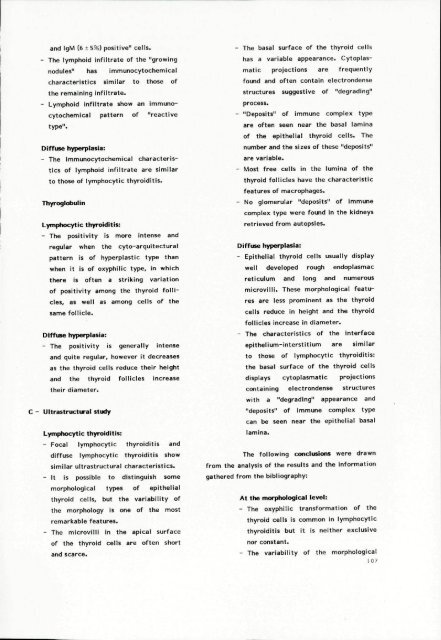Tireoidite linfocítica - Repositório Aberto da Universidade do Porto
Tireoidite linfocítica - Repositório Aberto da Universidade do Porto
Tireoidite linfocítica - Repositório Aberto da Universidade do Porto
Create successful ePaper yourself
Turn your PDF publications into a flip-book with our unique Google optimized e-Paper software.
and IgM (6 ± 596) positive" cells.<br />
- The lymphoid infiltrate of the "growing<br />
nodules" has immunocytochemical<br />
characteristics similar to those of<br />
the remaining infiltrate.<br />
- Lymphoid infiltrate show an immuno<br />
cytochemical pattern of "reactive<br />
type".<br />
Diffuse hyperplasia:<br />
- The immunocytochemical characteris<br />
tics of lymphoid infiltrate are similar<br />
to those of lymphocytic thyroiditis.<br />
Thyroglobulin<br />
Lymphocytic thyroiditis:<br />
- The positivity is more intense and<br />
regular when the cyto-arquitectural<br />
pattern is of hyperplastic type than<br />
when it is of oxyphilic type, in which<br />
there is often a striking variation<br />
of positivity among the thyroid folli<br />
cles, as well as among cells of the<br />
same follicle.<br />
Diffuse hyperplasia:<br />
- The positivity is generally intense<br />
and quite regular, however it decreases<br />
as the thyroid cells reduce their height<br />
and the thyroid follicles increase<br />
their diameter.<br />
C - Ultrastructural study<br />
Lymphocytic thyroiditis:<br />
- Focal lymphocytic thyroiditis and<br />
diffuse lymphocytic thyroiditis show<br />
similar ultrastructural characteristics.<br />
- It is possible to distinguish some<br />
morphological types of epithelial<br />
thyroid cells, but the variability of<br />
the morphology is one of the most<br />
remarkable features.<br />
- The microvilli in the apical surface<br />
of the thyroid cells are often short<br />
and scarce.<br />
- The basal surface of the thyroid cells<br />
has a variable appearance. Cytoplas-<br />
matic projections are frequently<br />
found and often contain electrondense<br />
structures suggestive of "degrading"<br />
process.<br />
- "Deposits" of immune complex type<br />
are often seen near the basal lamina<br />
of the epithelial thyroid cells. The<br />
number and the sizes of these "deposits"<br />
are variable.<br />
- Most free cells in the lumina of the<br />
thyroid follicles have the characteristic<br />
features of macrophages.<br />
- No glomerular "deposits" of immune<br />
complex type were found in the kidneys<br />
retrieved from autopsies.<br />
Diffuse hyperplasia:<br />
- Epithelial thyroid cells usually display<br />
well developed rough en<strong>do</strong>plasmac<br />
reticulum and long and numerous<br />
microvilli. These morphological featu<br />
res are less prominent as the thyroid<br />
cells reduce in height and the thyroid<br />
follicles increase in diameter.<br />
- The characteristics of the interface<br />
epithelium-interstitium are similar<br />
to those of lymphocytic thyroiditis:<br />
the basal surface of the thyroid cells<br />
displays cytoplasmatic projections<br />
containing electrondense structures<br />
with a "degrading" appearance and<br />
"deposits" of immune complex type<br />
can be seen near the epithelial basal<br />
lamina.<br />
The following conclusions were drawn<br />
from the analysis of the results and the information<br />
gathered from the bibliography:<br />
At the morphological level:<br />
- The oxyphilic transformation of the<br />
thyroid cells is common in lymphocytic<br />
thyroiditis but it is neither exclusive<br />
nor constant.<br />
- The variability of the morphological<br />
107

















